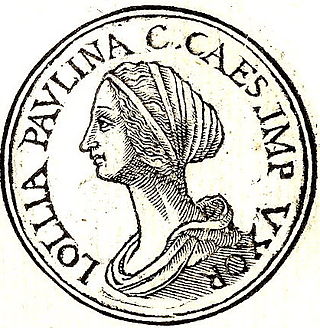Related Research Articles

Lollia Paulina was a Roman empress for six months in 38 as the third wife of the Roman emperor Caligula.
Marcus Lollius was a Roman politician, military officer and supporter of the first Roman emperor Augustus. His granddaughter Lollia Paulina would marry the emperor's great-grandson Caligula and become empress.
Decimus Valerius Asiaticus was a prominent Roman Senator of provincial origin. Asiaticus was twice consul: first in 35 as suffect consul with Aulus Gabinius Secundus as his colleague; second in 46 as ordinary consul with Marcus Junius Silanus as his colleague. He was the first man from Gaul to be admitted into the Roman Senate, as well as the first man from Gaul to attain the consulship.

Lucius Volusius Saturninus was a Roman senator from the powerful plebeian Volusia gens, or family. He held several offices in the emperor's service. Saturninus attracted the attention of his contemporaries for his long life: he died at the age of 93, and having sired a son at the age of 62.
Quintus Volusius Saturninus was a Roman Senator who lived in the Roman Empire during the Principate. He was consul in the year 56 with Publius Cornelius Scipio as his colleague.
Lucius Volusius Saturninus, also known as Lucius Volusius was a Roman Senator from the powerful plebeian Volusia gens, or family. He was a cousin of emperor Tiberius.
The gens Vitellia was a family of ancient Rome, which rose from obscurity in imperial times, and briefly held the Empire itself in AD 69. The first of this gens to obtain the consulship was Aulus Vitellius, uncle of the emperor Vitellius, in AD 32.

The gens Lollia was a plebeian family at Rome. Members of the gens do not appear at Rome until the last century of the Republic. The first of the family to obtain the consulship was Marcus Lollius, in 21 BC.
Publius Memmius Regulus was a Roman senator active during the reign of the emperor Tiberius. He served as consul suffectus from October to December AD 31 with Lucius Fulcinius Trio as his colleague, governor of Achaea from AD 35 to 44, and governor of Asia possibly in AD 48-49.
Publius Lollius Maximus also known as Lollius Maximus and Maximus Lollius was a Roman soldier who lived in the 1st century BC who served under the first Roman emperor Augustus.
Marcus Lollius was a Roman Senator who was active in the second half of 1st century BC and first half of 1st century. He is best remembered as the father of empress Lollia Paulina.
Quintus Volusius also known as Quintus Volusius Saturninus was a senator of the Roman Republic who lived in the 1st century BC.
Lucius Volusius Saturninus was a senator of the early Roman Empire, who was active during the Principate. He was a member of the College of Pontiffs.
Volusia Saturnina also known from her funeral inscription as Volusia Latina Saturnina was a Roman noble woman who lived in the Roman Empire in the second half of the 1st century BC and first half of the first century AD.
Decimus Valerius Asiaticus was a Roman Senator who served as a Legatus of Gallia Belgica.
Marcus Lollius Paullinus Decimus Valerius Asiaticus Saturninus was a prominent Roman Senator who was a powerful figure in the second half of the 1st century and first half of the 2nd century. He is also known by the shorter form of his name, Decimus Valerius Asiaticus.
Decimus Valerius Taurus Catullus Messallinus Asiaticus was a member of the Arval Brethren who lived in the second half of 1st century and first half of 2nd century.
The Volusia gens was an ancient Roman family.
References
- ↑ A bit of History – Lollia Saturnina
- ↑ A bit of History – Lollia Saturnina
- 1 2 Seneca the Younger, De Constantia sapientis, 18,2
- 1 2 Marcus Lollius’ article at Livius.org
- ↑ Genealogy of Lollius by D.C. O’Driscoll
- ↑ Genealogy of Lollius by D.C. O’Driscoll
- ↑ Harrison, Homage to Horace: A Bimillenary Celebration, p.290
- ↑ Tacitus, Annales , III.30
- ↑ Romeins Imperium – Lucius Quintus Volusius Saturninus translated from Dutch to English
- ↑ Rickman, Roman Granaries and Store Buildings, p.169
- 1 2 Wiseman, Talking to Virgil: A Miscellany, p. 75
- ↑ Wiseman, Talking to Virgil: A Miscellany, pp.74f
- ↑ Romeins Imperium – Lollia Paulina translated from Dutch to English
- ↑ Genealogy of Lollius by D.C. O’Driscoll
- ↑ The Roman World: Gallia Narbonensis's Urbs of Vienna Archived 2013-12-19 at archive.today
- ↑ Andreau, Banking and Business in the Roman World, p. 74
- ↑ Bernard J. Kavanagh, "Lollia Saturnina", Zeitschrift für Papyrologie und Epigraphik , 136 (2001), pp. 229-232